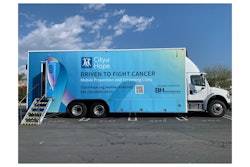Mortgage discrimination is tied to breast cancer outcomes, a study published February 20 in JAMA Network Open found.
Researchers led by Jasmine Miller-Kleinhenz, PhD, from Emory University in Atlanta found that living in a historically redlined area is tied to increased odds of estrogen receptor (ER)-negative breast cancer in non-Hispanic Black women and increased odds of late-stage diagnosis in non-Hispanic white women.
They also reported that persistent mortgage discrimination is tied to higher breast cancer mortality in non-Hispanic white women, while non-Hispanic Black women were more likely to die of breast cancer no matter where they lived.
“These findings emphasize the need for a more nuanced investigation of the social and structural drivers of disparate breast cancer outcomes,” Miller-Kleinhenz and colleagues wrote.
Black women have a slightly lower rate of breast cancer incidence compared with white women, but they are more frequently diagnosed with later-stage disease, the researchers noted. This includes more aggressive forms of breast cancer such as ER-negative disease.
Research by radiologists has demonstrated ties between social barriers to breast cancer screening access and outcomes. However, the Miller-Kleinhenz team pointed out that there is “limited understanding” of how societal structures drive inequitable outcomes.
Recent studies have shown that historical redlining, a form of mortgage discrimination that was largely based on the racial and ethnic composition of neighborhoods, has exacerbated racial disparities in breast cancer outcomes. While this practice has been outlawed, the practice of contemporary mortgage discrimination persists.
The researchers wrote that these practices may have downstream implications, which they analyzed for their study. Using Georgia Cancer Registry data, they included information from 1,764 non-Hispanic Black and white women with a breast cancer diagnosis and who reside in an area graded by the Home Owners’ Loan Corporation (HOLC) in Georgia. The women were diagnosed with a first primary breast cancer between 2010 and 2017.
Of the total women, 856 were non-Hispanic Black and 908 were non-Hispanic white. Additionally, 1,148 (65.1%) were diagnosed at 55 years or older, 538 (30.5%) resided in areas with historical redlining scores of less than 2.5 (not redlined) and 1,226 (69.5%) resided in areas with scores of 2.5 or greater (redlined).
The researchers reported that living in redlined areas was tied to a 62% higher odds of ER-negative breast cancer among non-Hispanic Black women, with an odds ratio (OR) of 1.62. Living in redlined areas also led to a 97% increase in odds of late-stage diagnosis among non-Hispanic white women (OR, 1.97) and a 60% increase in breast cancer mortality overall (hazard ratio, 1.6).
Finally, the team found ties between persistent mortgage discrimination and breast cancer mortality among non-Hispanic white women but not among non-Hispanic Black women.
The study authors highlighted that their results suggest “robust and interacting” structural and social determinants of health faced by Black women.
“The isolation of one domain, neighborhood in this instance, does not mitigate insults from others — that is, a piling of effects,” they wrote.
However, they reported that white women experienced fewer structural and social determinants of health, meaning more robust effects were observed when considered in isolation.
“Our observations reinforce the concept of race as a social construct and emphasize the need for a more nuanced investigation of the differing social and structural drivers of disparate breast cancer outcomes,” the authors added. “Additional methods and approaches are needed to capture the intersecting influences from multiple social and structural domains on race disparities in breast cancer mortality.”
The full study can be found here.



















